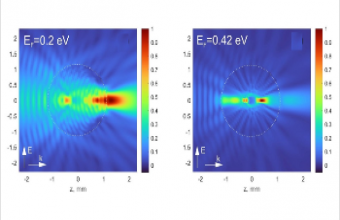Scientists from Tomsk Polytechnic University (TPU) and Belarusian State University have made a groundbreaking discovery that could significantly improve the resolution of modern terahertz (THz) imaging systems. The team successfully demonstrated, for the first time, that a photonic jet—a highly focused beam of light—can be generated using high refractive index dielectric particles by applying a graphene coating. Previously, this phenomenon was believed to be achievable only with low refractive index materials.
The research focuses on leveraging graphene's unique properties to control and enhance the electromagnetic field behind dielectric particles. By coating a dielectric sphere with a graphene film, the researchers triggered a Fano resonance, amplifying the electromagnetic field in the terajet locus. This interaction resulted in a higher field intensity than previously possible, offering real-time control over the power, size, and focus of the generated photonic jet.
This advancement is particularly important for THz imaging, a technique used to achieve superresolution imaging beyond the diffraction limit in applications ranging from medical diagnostics to industrial non-destructive testing. "The optical properties of graphene vary with external potential, making it a flexible material for constructing structures with controllable spectral responses," said Igor Minin, professor at TPU's Division for Electronic Engineering.
The TPU researchers' approach addresses a key challenge in THz technology—managing dielectric losses that are five to seven times higher in the microwave and THz ranges compared to the optical range. Traditionally, the fixed properties of dielectrics have limited the ability to adjust photonic jet parameters during operation, restricting the practical use of terajets in dynamic imaging systems. However, by introducing graphene into the equation, these parameters can now be finely tuned in real-time, offering enhanced control over the imaging process.
In their study, the TPU team employed computer modeling to explore how a single graphene layer applied to a dielectric sphere could dynamically adjust the photonic jet's properties. This flexible solution is expected to revolutionize THz imaging systems by providing unprecedented control over imaging resolution, particularly in applications that require high precision, such as material science, security screening, and biomedical imaging.
The researchers believe their findings could have broad implications beyond THz imaging, potentially influencing the design of next-generation sensors and diagnostic tools. "The use of graphene-coated dielectric spheres opens up new possibilities for controlling terajet parameters, which could significantly improve the performance of tunable THz systems," Minin added.
This discovery marks a significant leap forward in the field of experimental mechanics and photonic technologies, offering new opportunities for enhancing imaging techniques in various scientific and industrial fields. The collaboration between TPU and Belarusian scientists continues to push the boundaries of what is possible in the realm of advanced imaging technologies.












